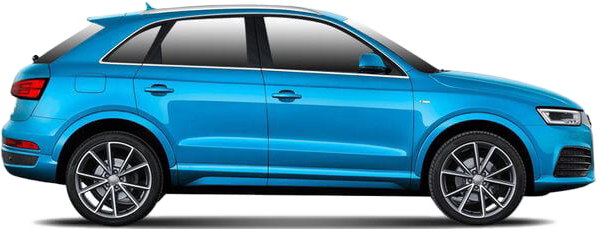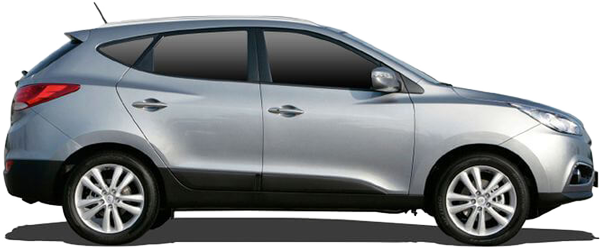The Comparative Analysis :
Audi Q3 2.0 TDI (15 - 18) vs. Hyundai ix35 Fuel Cell (15 - 18)
€ 33,700

€ 65,500

€ 33,700
Base Price ⓘBase price of a new vehicle with standard equipment in Germany at market launch.
€ 65,500
ⓘBase price of a new vehicle with standard equipment in Germany at market launch. Price Info
Vehicle Dimensions
The dimensions of these vehicles differ a little. The Audi Q3 2.0 TDI is 2.2 cm shorter, 1.1 cm wider and 6.5 cm lower than the Hyundai ix35 Fuel Cell.
Audi Q3 2.0 TDI
Hyundai ix35 Fuel Cell
1590
1831
2019
1655
1820
2100
1831 mm
Width
1820 mm
2019 mm
Width Incl. Mirrors
2100 mm
1590 mm
Height
1655 mm
2603
4388
2640
4410
4388 mm
Length
4410 mm
2603 mm
Wheelbase
2640 mm
Vehicle Weight
Audi Q3 2.0 TDI
Hyundai ix35 Fuel Cell
1560 kg
Kerb Weight
1921 kg
2085 kg
Gross Vehicle
Weight
Weight
2250 kg

Weight Difference:
361 kg
18.79 %

General
Audi Q3 2.0 TDI
Hyundai ix35 Fuel Cell
8U
Generation
EL
Sport Utility Vehicle
Car Body Style
Sport Utility Vehicle
Diesel
Fuel Type
Hydrogen

Front-wheel drive
Drive
Front-wheel drive

6-speed manual transmission
Transmission
1-speed automatic transmission
Engine
Audi Q3 2.0 TDI
Hyundai ix35 Fuel Cell
Straight-four diesel engine with turbocharger
Engine Type
Asynchronous motor
CUVC, DBBA, DFTA
Engine Code
4
Valves
0
4
Cylinders
0
1968 CC
Engine Capacity
0 CC
148 bhp
at 3500 rpm
Power
134 bhp
at 0 rpm
Audi Q3 2.0 TDI
148 bhp
134 bhp
Hyundai ix35 Fuel Cell
340 NM
at 1750 rpm
Max. Torque
300 NM
at 0 rpm
Audi Q3 2.0 TDI
340 NM
300 NM
Hyundai ix35 Fuel Cell
Performance
Audi Q3 2.0 TDI
Hyundai ix35 Fuel Cell
127 mph
Maximum Speed
99 mph
9.6 sec
Acceleration 0 to 62 mph
12.5 sec
62 mph
62
mph
mph
133 m
0.000 sec

Audi Q3 2.0 TDI
62 mph
62
mph
mph
174 m
0.000 sec

Hyundai ix35 Fuel Cell
▶ REPLAY
10.54 kg/bhp
Weight-to-Power Ratio
14.34 kg/bhp
Audi Q3 2.0 TDI
10.54 kg/bhp
14.34 kg/bhp
Hyundai ix35 Fuel Cell
Fuel Economy / Emissions
Audi Q3 2.0 TDI
Hyundai ix35 Fuel Cell
Fuel Economy
64 mpg
( 72 MPGe ⓘ Miles per gallon petrol equivalent (MPGe) is a measure of the average distance traveled per unit of energy consumed. MPGe, specified in miles per imperial gallon (~4.546 litres), is used to compare the energy consumption of vehicles that use different energy sources.)
combined ✽ per 100 miles
1.6 kg H2✽
( 75 MPGe ⓘ Miles per gallon petrol equivalent (MPGe) is a measure of the average distance traveled per unit of energy consumed. MPGe, specified in miles per imperial gallon (~4.546 litres), is used to compare the energy consumption of vehicles that use different energy sources.)
Audi Q3 2.0 TDI
72 MPGe
75 MPGe
Hyundai ix35 Fuel Cell
56 mpg
city
1.4 kg H2
No data
motorway
1.6 kg H2
64 L
Fuel Tank Capacity
5.6 kg
904 mi
Range
348 mi
Audi Q3 2.0 TDI
904 mi
348 mi
Hyundai ix35 Fuel Cell
Environmental Impact
90.4 kWh
Total Energy Consumption
per 100 miles ⓘThe total energy consumption per 100 miles is the amount of energy consumed by a vehicle when burning fuel or using electricity per 100 miles (final energy), and the energy required to produce the appropriate amount of fuel or electricity (primary energy).
per 100 miles ⓘThe total energy consumption per 100 miles is the amount of energy consumed by a vehicle when burning fuel or using electricity per 100 miles (final energy), and the energy required to produce the appropriate amount of fuel or electricity (primary energy).
131.5 kWh
Audi Q3 2.0 TDI
90.4 kWh
131.5 kWh
Hyundai ix35 Fuel Cell
Euro 6b (NEFZ)
Emission Standard
Brennstoffzelle (Wasserstoff)
116 g/km (NEFZ)
CO2 Emissions
0 g/km (NEFZ)
Practical Convenience
Audi Q3 2.0 TDI
Hyundai ix35 Fuel Cell
5
Doors
5
5
No. of Seats
5
525 kg
Maximum Payload
329 kg
460 L
Boot Capacity
591 L











1365 L
Boot Capacity (Seats Down)
1436 L














